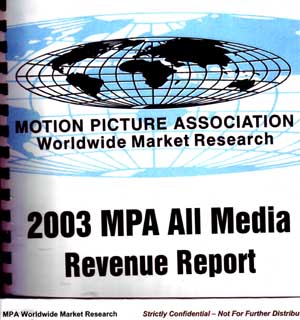| The
Hollywood Economist
The numbers behind the industry.
The madness of movie advertising.
By Edward Jay Epstein
Consider the perverse logic of Hollywood: In 2003, the six
major studios—Disney, Warner Bros., Sony, 20th Century
Fox, Universal, and Paramount—spent, on average, $34.8
million to advertise a movie and earned, on average, just
$20.6 million per title. Even if the studios had made the
movies for free—which, of course, they didn't—they
would have lost $14.2 million per film on the theatrical
run, or what the industry calls "current production."
Given the fleeting attention span of the target audiences
(mainly TV-watching teens) and the unmemorable nature of
the ad copy, the studios believe they must show the same
ad on the same programs at least eight times in order to
draw an audience. As a result, the studios spend more to
lure a teenager into a theater than they receive at the
box office, which is reminiscent of the joke about the idiot
in the garment business who "loses money on every sale
but makes it up on volume."
The
moguls who run New Hollywood are anything but idiots, however,
so, after I was given access to studio budgets, I asked
a very savvy executive at 20th Century Fox how the studios
recover this huge advertising expenditure.
He
explained that big opening-weekend numbers, even if they
are expensively acquired, may pay off in later markets—specifically
video, pay-TV, and foreign release. At that time, the year
2000, he was right: Video chains like Blockbuster mechanically
pegged their orders, which could range from 1,000 copies
to 300,000 copies for a single title, on the results of
the theatrical opening. So did pay-TV channels, such as
HBO. And, since movies were typically released overseas
many months after their American debuts, studios could use
impressive U.S. box-office numbers to wrangle more advantageous
play dates in foreign markets.
Since then, however, the digital revolution has radically
changed the movie business. The video rental market, which
had been the studios' cash cow as late as 2000, is rapidly
disappearing. It's been replaced by the business of selling
DVDs in which a handful of mass retailers, such as Wal-Mart,
account for most of the studios' revenues. Unlike the video
chains that rented videos, the big retailers don't simply
peg their orders to a film's box-office results. Instead,
they view DVDs as traffic-builders: The stores use them
to lure in the relatively well-heeled, plasma-screen-purchasing
customers—who are usually not the so-called LICs (or
low-income consumers) who are recruited by ads for movie
openings. As a rueful Sony marketing executive pointed out,
"Unfortunately, our teens are not always who they want."
In addition, unlike the video-rental business, the studios
pay the full costs of returns: DVDs can be returned by stores
after 60 days if they do not bring in the desired traffic.
Returns can be very costly, as DreamWorks Studios recently
found when it got back 7 million copies of Shrek 2.
DVDs also changed the equation for pay-TV channels. Customers
who own high-quality DVDs of a movie are less likely to
pay to see the same movie six months later on Showtime.
So, the pay-TV channels substituted original programming,
such as The L Word, and greatly reduced the amount
they paid for box-office blockbusters—making impressive
theatrical numbers even less of a factor.
Finally,
the digital revolution has a dark side—zone-free DVD
players, DVD piracy, and Internet file sharing—that
deeply alters the scenario for foreign distribution. Because
movies can now be illegally circulated around the world
the instant they open in the United States, the studios
have begun to abandon their practice of staggering foreign
openings. As a Fox vice president told Variety in 2005,
"Waiting three or four months after domestic [release]
to release our bigger pictures [overseas] is not something
we can do anymore." The latest episode of Star
Wars opened on the same weekend in the United States
and in 59 other countries. With these simultaneous openings,
the U.S. box office obviously came too late to help get
better foreign play dates.
All
of these changes add up to a growing disconnect between
the money poured into advertising for a large theatrical
gross and the earnings realized in the markets that the
studios depend on for their money. (Click here to see the
money machines.)
Does
Hollywood need to remain so out of synch with reality? At
present, the studio marketing arms have become exceedingly
efficient at stampeding weekly herds of teens to multiplexes
and producing impressive numbers. But if that amazing trick
turns out to be not worth its average $34.8 million price
tag, studios will have to consider different strategies.
The most obvious one would be to eliminate the long interval
between a film's opening and its release on DVD. Also, if
the studios aimed at the much larger and more profitable
DVD audience, they would not need to spend so much on the
teen herd. In this regard, Mark Cuban and Todd Wagner, who
own the Landmark Theatres chain, the distributor Magnolia
Films, and the high-definition cable channel HDNet, have
announced just such a radical strategy. They will finance
six movies directed by Steven Soderbergh and release each
one simultaneously in movie theaters, pay-TV, and on DVD.
To follow suit, the Hollywood studios might also need a
different class of movies.
[back
to archive]
|



